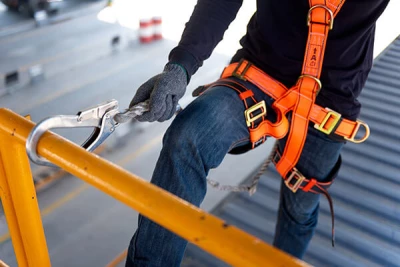Fall Protection Week
Published 5.2.2022
This week is dedicated to the National Safety Stand-Down to Prevent Falls in Construction. We are going to focus on this topic because falls continue to be a leading cause of fatalities in the construction industry. The question is, why do they continue to happen?
We know that the risk for falls is virtually present all around us, however, the factors that can lead to a fall vary greatly. There are many specific unsafe acts by employees as well as unsafe conditions that lead to fall incidents. Falls often result from a series of contributing factors. They are often the result of multiple unsafe conditions and unsafe actions combined. Because of this fact, it is important to look at unsafe conditions as well as unsafe actions to recognize hazardous situations when working at heights.
Unsafe conditions that lead to falls
- Unguarded leading edges
- Open holes
- Improper guardrails
- Damaged equipment (ladders, stairs, safety tools, etc.)
- Slippery conditions
- Unmarked elevation changes
Unsafe actions that lead to falls
- Working at heights without fall protection or fall prevention methods in place
- Improper use of ladders
- Leaning over guardrails
Knowing that both unsafe conditions and actions are the primary contributors to falls in the workplace, how do we ensure we don't have another serious fall at Hudson Bay?
I am looking to you for those answers because only you can determine those actions. We ask that you all have an honest and open discussion about this topic this week amongst yourselves. Commit to your co-workers, your families and yourselves that nothing will compromise your decision to always evaluate and mitigate all fall hazards to the safest level possible. It’s the only way you get to go home.
Remember this!
Fall hazards are foreseeable, and if they are foreseeable, then they are certainly preventable. you can identify them, you can eliminate your exposure to them, and you can control them before they can lead to an injury or death.
Properly Using Beam Straps
Published 5.9.2022
One of the most important aspects of personal fall protection systems is fully planning the system before it is put into use. Probably the most overlooked component is planning for suitable anchorage points for tie-off or the misuse of anchor points. One of the most common mistakes we see in the field is with the Beam Strap/Tie-Off Adapter or sometimes called a “D-ring”. Let’s improve that now.
Inspecting our equipment
- When inspecting our beam strap, we are looking at the condition of the webbing and stitching.
- The webbing must be free of frayed, cut, or broken fibers.
- Check for tears, abrasions, mold, or discoloration.
- Check for cut or pulled stitches.
- Check the mental D-rings for sharp edges, burrs, cracks, or corrosion.
All of the above factors contribute to the reduced strength of our anchorage connector. Any damaged or questionable connectors must be removed from service immediately.
Installing the beam strap
The only and correct way to install the beam strap is to place the strap over your desired anchorage location with the labels facing out. The D-rings must be hanging below your anchorage site. Pass the small D-ring through the large D-ring and snug to take up any slack.
To shorten the length of the beam strap and to reduce the amount of free-fall, multiple passes may be needed. To accomplish this, you will continue to pass the small D-ring around and through the large D-ring on each pass until your desired length is reached. Remember that the small D-ring should be below the anchorage site.
Just like installing a beam strap, the same is true for connecting to it. We only use self-locking snap hooks and carabiners - it is a one-to-one connection, meaning, your snap hook can only connect to the small D-ring, not both.
Remember This!
Your anchorage point is the starting point for your fall protection system; if installed incorrectly, it can also be the starting point for a system failure.
Ladder Safety
Published 5.16.2022
At Hudson Bay Insulation, we take pride in everything we do. Our scope of work is often performed at heights that are known to be very hazardous - that is why we stress ladder safety heavily. Let's take a look at the 2020 national statistics.
- 805 fatalities occurred, 300 of which were directly attributed to ladders
- 211,640 workers were injured and required days off from work
Falls are 100% preventable. Did you know that most ladder deaths are from falls of 10 feet or less? Whether we are working from a ladder, near the leading edge of a roof or scaffolding, it's important to plan ahead, assess the risk and use the right equipment.
Reminders when using all types of ladders
- Always inspect ladders prior to each use
- Discuss the task with coworkers and determine what safety equipment is needed
- Do not overload ladders beyond their maximum intended load
- Use ladder only for their designed purpose
- Secure ladders in place in areas such as passageways, doorways, or where they can be displaced by other work activities or traffic
- Keep areas clear around the top and bottom of ladders
- Do not move, shift, or extend ladders while in use
- Face the ladder when traversing up or down
- Do not carry objects or loads that could cause loss of balance and falling
- Use 3-points of contact when traversing the ladder at all times
- Do not walk the ladder or lean against the wall
- No climbing above the 2nd step from the top on A-frame ladders
Remember This!
Fall hazards are foreseeable, and if they are foreseeable, then they are certainly preventable. You can identify them, you can eliminate your expose to them, and you can control them before they can result in an injury or death.
Rescue Plans
Published 5.30.2022
When an emergency strikes, the time to prepare has passed.
This month we invested our safety meetings in fall prevention and protection. This week is dedicated to the vital importance of rescue plans. After you fall, you may find yourself hanging upright and motionless while awaiting rescue. This post-fall position often constricts blood flow and can result in loss of consciousness in as little as 6 minutes - known as suspension trauma. The presence of preexisting injuries, environmental pressures and increased user stress can all accelerate suspension trauma and can result in a serious or fatal injury within 30 minutes of an incident. Knowing the dangers, developing a rescue plan is as important as anything else we do when working at heights. When a person falls, there may not be a straightforward way to get them down safely in a timely manner. Therefore, we must use page 3 of our Fall Protection Work Plan to develop that course of action.
This plan is outlined by 5 sections and enables us to greatly improve rescue time and reduce the onset of suspension trauma. In these sections we identify Rescue & First Aid teams as well as a jobsite contact. We also identify the Rescue Equipment that will be needed as well as a Communication or Method of Contact Plan between the injured worker, rescue teams, and the supervisor. The Rescue Procedures describe the pre-work tasks that will need to be done prior to the start of work and the step-by-step response procedures. Lastly, our plan covers any special considerations or coordination that may need to be addressed to maximize the effectiveness of our rescue operation.
All these things should be thought of and ready for use in case of an emergency. If the appropriate rescue equipment or number for an outside agency is not readily available in the case of an emergency, the time wasted could be the difference between life and death for a worker who is suspended after a fall.
Rescue procedures should include the following actions:
- If a worker is suspended and self-rescue is not possible, or if rescue cannot be performed right away, the suspended worker should pump their legs frequently to reduce blood pooling.
- After the suspended worker is brought down, seat them in a W position.
- Do not allow rescued workers to lie flat or stand upright after rescue.
- If the rescued worker is unconscious, keep their air passages open and provide first aid.
- Workers who are rescued after being suspended should go to the hospital immediately.





